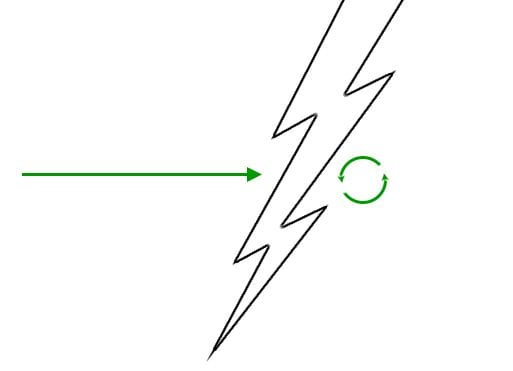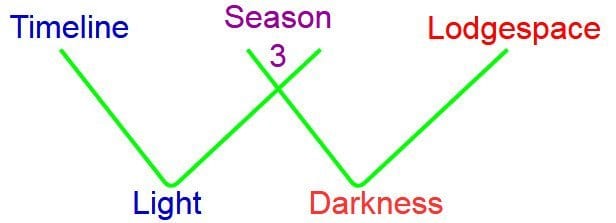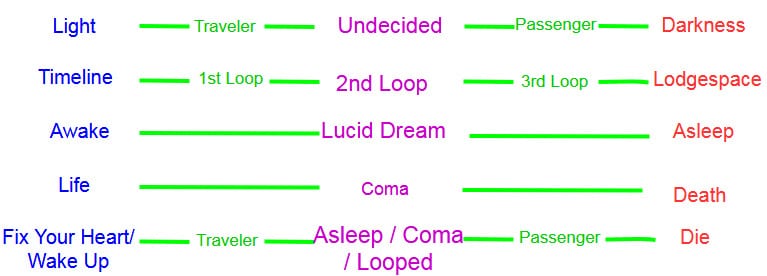Twin Peaks Season 3 has taken a lot of flack for not feeling like there are protagonists, antagonists, or even things they want. At the time, I knew it had to be purposeful, but all the same I couldn’t quite understand it. But over time, I’ve come to this conclusion:
I think Season 3 is all about how characters come to make the decision to break through their trauma and send their energy in a positive direction (to the Timeline, where the truth is that Laura dies) or a negative direction (to Lodgespace, where Carrie unrecognizably lives).
The option for characters to choose between Timeline and Lodgespace is, as I’ve explained earlier in this Twin Peaks theory, best exemplified by this exchange between Lucy and the Insurance Salesman in Season 3 Part 1:
Insurance Salesman: “I’d like to see Sheriff Truman.”
Lucy: “Which one?”
IS: “Sheriff Truman isn’t here?”
L: “Well, do you know which one? It could make a difference.”
IS: “Uh, no, ma’am.”
L: “One is sick, and the other is fishing.”
What happens to the salesmen after these words? He panics and leaves before choosing to speak to either sheriff. He didn’t know which one to speak with so he spoke to neither.
His indecision is a microcosm of every character struggle in Season 3: the characters are frozen in place by trauma and/or stagnation, and their biggest struggle is to break through the barrier that strands them in their personal and external trauma. Trauma freezes you in place. So does being stuck in a rut. Your energy is not flowing. It’s stuck in the middle, not part of the flow that goes between and through the material and non-material states of reality, what I’m calling the Timeline and Lodgespace. Scream. Break the dam. Your energy will flow again. You are no longer stuck between states. You are traveling again.
And once your energy begins moving, you can choose how to direct your energy, as best expressed by this dialogue between Hawk and Frank in Part 11:
Hawk: “[the symbol]’s a type of fire, more like modern day electricity.”
Frank: “Good?”
Hawk: “It depends. It depends on the intention, the intention behind the fire.”
I still firmly believe what I wrote in The Central Question of Twin Peaks: When confronted with trauma, do you look away or shovel yourself out? where I suggested that every character in Season 3 processes their trauma and then immediately leaves the story. Now that I’ve dissected the reality structure as I have in this Twin Peaks theory, I can finally offer you a plausible reason as to how and why this happens. Most of it involves tuning from the in-between state to either the Timeline or Lodgespace, which to viewers usually looks like someone remembering something.
Breakthroughs are a major focus in Season 3. Every time someone screams, you know someone’s broken through their wall and are on their way to waking up. But it takes a lot to get to that moment. It takes a while. Remember how long it took Dale to wake up? Surely, Dougie drinking the coffee will wake up Cooper, right? Surely, sex with Janey-E will wake him up. That “damn good” pie with the Mitchums, right? Everything in Season 3 felt like the perfect trigger to get Dale Cooper back to us, but it wasn’t just one of those things. It was all of them, added together, adding weight until the veil was pushed back and Dale had no choice but to “wake up!”
We’re going to see the characters we remember this week, right? It took way longer into new Twin Peaks than we were expecting before we saw characters we were dying to see again (read: Audrey, Big Ed) and when they did arrive they were not announced with any major gravitas. They just showed up.
We’re going to have a breakthrough and energy will start moving in a positive direction now, right? It always takes longer than you think to heal, doesn’t it? And you never know you’re healed, you never know you actually processed your trauma, until you do. And you probably already did it before you realize you’ve done it.
I will show you here how the characters get to the point of jump-starting their energy, and how their breakthroughs allow themselves to see the Timeline or Lodgespace clearly enough that they decide to anchor themselves to one or the other, rather than the interminable state between, belonging to neither.
The Trauma Cycle — how characters were caught between
Trauma freezes energy. It stalls it to a hard stop. Stagnation, the force that puts Norma and Ed into Season 3, sets in. In terms of the energy flow as described earlier, it looks like this:

A character’s energy needs a shock to its system to be restarted. It’s what Dale eventually understood when he put that fork in the socket in Part 15: he needed to restart his energy flow as part of the system of natural energy that he knew he wanted to be a part of again.
His cycle looks like this:
 In a more general terms, I’ve broken down the stages each character uses to process their trauma:
In a more general terms, I’ve broken down the stages each character uses to process their trauma:
 And then I’ve matched it up to the timeline of Cooper’s time loops, per Cooper’s greater arc of processing the trauma he incurred when he entered the Lodge (each of his time loops represent a stage of the trauma cycle):
And then I’ve matched it up to the timeline of Cooper’s time loops, per Cooper’s greater arc of processing the trauma he incurred when he entered the Lodge (each of his time loops represent a stage of the trauma cycle):

Dale’s point of trauma in this case is the Episode 29 events in the Waiting Room. The moment that restarts his energy from that point is not the fork (that was a smaller point of understanding) but “what year is this?” Understanding that he’s disconnected from time is a trauma that Jeffries went through and that Dale is now going through. Dale is at a precipice in the final credits. Will he decide (at all) if he’ll use his energy for the positive, re-embrace the timeline and repent for the trauma he caused to the timeline during his loops (much as Ben Horne did in The Final Dossier for inviting the prison into the Twin Peaks area when he sold his land, and now tries to help where he can whenever he can) or will Dale choose to become a monster in the vein of like Phillip Jeffries, or be like Sarah Palmer, feeling like she must have been a monster and therefore invited a monster inside her retroactively.
Will Carrie’s scream wake Dale up (“Finally!”) or will he stay in the dark dream like little Denny Craig, who per Maggie in Part 4 took Sparkle, the bell rang (what was supposed to shock Denny’s system awake), and he just never woke up?
Last time, I focused mostly on Margaret’s words in Part 10 about a dream flowing like a river at her. This time I’ll be focusing on Lucy’s words about which Truman that Insurance Salesman wants to see, and Hawk’s words to Frank about the intention behind the fire, which I equate to the intention of your energy showing you the Timeline or Lodgespace.
Travelers and passengers
Margaret Coulson, in Final Dossier, spoke of passengers and travelers, and striving to be a traveler because a traveler embraces and fosters Light, both in oneself and in others.
I include this, which was from the Final Dossier Deep Dive here on 25YL:
Don’t be sad. Be happy to have another day to do what needs doing.” It implies sadness is an emotion associated with being stuck in place. She goes on to say there is no light without darkness and we should make peace with that. And, whether we see that as a metaphor or fact “both tell us that time—and light, and darkness—move in cycles. We move through them, too, often as passengers, but if our eyes are open, there is much to be learned along the way. A traveler learns more than a passenger. When darkness comes, a traveler learns to be brave, for they know the light will return.
 Much as Cooper is going through the stages of trauma, or being asleep, everyone in Season 3 is one of the people Margaret speaks of in Final Dossier.
Much as Cooper is going through the stages of trauma, or being asleep, everyone in Season 3 is one of the people Margaret speaks of in Final Dossier.
Travelers know who they are and are heading for the Timeline.
Passengers don’t take responsibility to know themselves and they allow darkness to cover them. Their energy remains stagnant when their bell rings.
In terms of fitting the concept of travelers and passengers next to Season 3 concepts, I give you these associations:

Most people in Season 3 spend time as both travelers and passengers, oscillating between the two outlooks not unlike that clock in the sheriff department unable to move backward to 2:52 (which would be 3rd Loop in this metaphor) or forward to 2:53 (1st loop), spending most of its energy in between them (2nd Loop). We also see this metaphor in the arm wrestling scene. It’s more comfortable to go back to the starting position of indecision.
Oscillations keep characters spinning in place, stuck in loops, or otherwise unable to break through to win the match or make the clock hands move all the way. How does someone punch the resistance in the face, so you can break through the logjam (or negativity) holding you in place?
By fixing your heart.




Thanks John!
After reading Dion Fortune’s ‘Psychic Self Defence’ I noticed she writes about the Qaballistic Tree of Life having a double Of itself. It is called the Qlippoth. This Qlippoth is a ‘Mirror’ set of Demonic emanations which are produced from the instability of the sephiroth of the Tree of Life coming into being. This demonic mirror world is the one that Black Lodge magicians work with in their magick. So we have the two worlds here. This is in tune with what you say about the Buddhist viewpoint of two worlds. Thoughtforms are also mentioned in the book – they require part of the original magician or victim’s prana/chi or life force.
Mark Frost has been reported to have used this book along with Talbot Mundy’s ‘The Devils Guard’ in the development of the OG twin peaks.
Sounds perfectly in line! I bet I’ve been accidentally reverse-engineering this stuff…you’ll probably this one from Laura Stewart too. https://25yearslatersite.com/2020/02/14/twin-peaks-the-theosophical-history-of-the-dweller-on-the-threshold/
John this is so well written and thought out. How many times have you seen Season 3?
This is great work! There’s so much depth here that I never picked up on before. I’m intrigued and impressed with your theory and research. I’ve been kind of obsessing over the “Fire Walk with Me” poem for a while, since before I ever saw Season 3, and I have an alternate explanation that I think is in line with your primary thesis but not the exact interpretation that you arrived at: It seems to me that “through the darkness of future past, the magician longs to see” is about the Lodgespace/dream taking over, changing memories and events. “Future past” would normally mean “present”, but in this context it’s an altered present by a “magician” (Lodgespace / negative energy) using “fire” / electricity / magic, as multiple timeline loops overlap with reality. I think that this is the negative energy “longing to” oppose the reality of trauma and the timeline. I agree that “fire, walk with me” can refer to a positive energy breaking stagnation as you suggest, but I think it was most likely intended negatively, as it was originally BOB / Mike’s saying (before Mike cut off The Arm and was still BOB’s partner). Also, I believe that The Fireman (one who puts out fires) is a clear opponent to the forces of evil, solidifying the “fire is evil” motif.
Thanks for your great work here. I’m excited to keep digging deeper! Cheers!